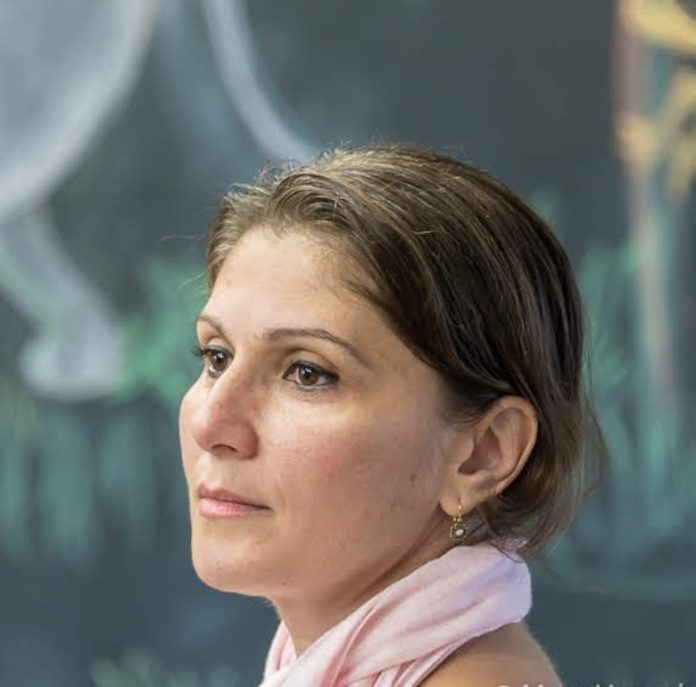Julieta Rotaru is a contract teacher of Romani Chib and Sanskrit at the National Institute of Oriental Languages and Civilizations (INALCO), Paris, and holds a course on Vlax Romani dialect, at the École Pratique des Hautes Études. She is also the managing editor of “Romani Studies. Journal of the Gypsy Lore Society”, published by Liverpool University Press, and the general secretary of this scholarly society which was established in 1888. She introduced a Romani language course at the École Pratique des Hautes Études in Paris, but also implemented an undergraduate program in Romani at the University of Bucharest. What preceded it and what is currently the focus of her research work she shares with Phralipen:
The Romani language is represented in France by three dialects: Sinti, Vlax, and Caló. They have been largely documented. “Vlax” dialects, in general, are influenced by Romanian, thus referring to the Romani speakers historically originating from the Romanian Principalities. The grammars and dictionaries of André Barthélémy and Georges Calvet, the works of anthropological-linguistics of Patrick Williams are such corpora for Kalderash dialect collected in the historical communities in Paris region, works with which the students of linguistics, or anthropology or even political science who are attending my course at the École Pratique des Hautes Études are already familiar. The course which I offer, entitled “Historical Documentation of the Vlax Romani spoken in Southern Romania”, is aimed at understanding the history of the corpus of texts produced in the Danubian Principalities during the 19th century.
In Paris, the École Pratique des Hautes Études has a very rich experience in teaching Middle Indo-Aryan languages, and also Romani Chib. Armand Minard, a disciple of Louis Renou, the holder of the chair of “Sanskrit Language and Literature” at the Sorbonne University, taught here Vedic texts with comparative introductions to various languages, including Romani.
In Romania, there is no tradition of teaching Sanskrit, though Sanskrit research has a rich history, as systematically addressed by Romanian scholar Liviu Bordaș in his studies on the historiography of the field. Bordaș portrays in detail the profiles of Sanskrit scholars and enthusiasts. Similarly, there is no tradition of teaching Romani.
Acquaintance of Western Europe with Indian languages has expanded proportionally with the commercial needs whereas the study of Romani has been a by-product, I may say. But I wouldn’t go so far back in time to prove that studing Romani has been embedded in the study of Indian languages. Immediately after the fall of the communist regime in 1991, the Indologist Milena Hübschmannová founded the Romani Studies Program at Charles University in Prague, between 1991-1997, at the undergraduate level, as part of the Institute of Indology, with disciplines covering various stages of the evolution of the Romani language as a precursor to Middle Indo-Aryan languages, including Urdu.
The University of Bucharest followed this trend thanks to the efforts of Professor Gheorge Sarău, supported by the then Dean of the Faculty of Foreign Languages and Literatures, the renowned Latin scholar Iancu Fisher, and the Professor of Indo-European linguistics Lucia Wald, who happened to be my guides. I graduated in Classical philology from the University in Bucharest (1994-1998). Since 1997, Romani has functioned as a specialization B within the Hindi-Romani Section, and from 2005-2006, as a specialization A, a status it has maintained to the present day, based on the periodic evaluations in which I have participated until 2015.
In 1996, with the support of Professor Gheorghe Sarău, who was preparing the future staff for the Romani Language Section, and upon the recommendation of Profesor Iancu Fisher, I obtained a scholarship at the University of Delhi as part of an intergovernmental cultural and scientific exchange program between Romania and India inherited from the communist period. I next continued to deepen my knowledge of Sanskrit, pursuing a master’s degree in Sanskrit (Vedic) at a traditional University in Pune, Tilak Maharashtra Vidyapeeth, from 1998 to 2000. Upon completion of my master’s degree, I returned to the University of Bucharest, where I attended a course in the Romani language (2000-2001). Together with a senior colleague, we taught a crash course on Indian Culture and Civilization aimed at students of Romani background who were being trained as Roma mediators. In this course, as a token of recognition, we included a translation of the “Short Grammar of the Sanskrit Language” written by Rajko Djurić.
In the same year, I introduced two elective courses at the University of Oradea, in the North of Romania, “Introduction to Sanskrit Language” and “Ancient Indian Civilization and Culture”. As an outcome of this, two students from that university obtained scholarships to India, while the Embassy of India in Bucharest offered a book donation to the University Library and the Bihor County Library, respectively.
In the next academic year, 2001–2002, I continued and diversified my linguistic training by completing the Hindi language program at the Central Institute of Hindi (Kendriya Hindi Sansthan) in Agra, India. The following year, 2002–2003, I specialized in editing ancient Indian texts at the Research School of Asian and Amerindian Studies (CNWS), Leiden University, Netherlands. From this institute, I obtained a valuable book donation, brought to the Romani section at the University of Bucharest.
Between 2004 and 2015, I taught at the Romani language section. In the first four years, I taught pro bono as a doctoral student on a full-time basis. As part of the doctoral program and at the recommendation of Professor Lucia Wald who was very instrumental in the creation of Romani teaching at the University of Bucharest, as I said in the beginning, to strengthen linguistic preparation for a future tenure in Romani, I attended the Romani language course between 2004-2006 and regularly the summer courses in Romani language organized at Costinesti.
Throughout these endeavors, I have involved my international network of professors and colleagues, who did not remain indifferent to my call and intention to develop Sanskrit studies in my homeland. With their support, we have created the Center for Eurasian and Afro-Asian Studies (CEAS) in Bucharest where, from 2008 to 2013, as a Research Associate, I organized numerous international conferences (the published proceedings amount to nearly 3,000 pages) and workshops on Indian prosody and codicology.
Being hyperspecialized in Vedic studies (I work on rare, unpublished texts from a little-studied Vedic tradition), I might have been perceived as somewhat disconnected in Romanian academic circles. In 2015 there was a sudden political and administrative decision to change the profile of the CEAS to general cultural studies. Also in 2015, following an intra-departmental decision regarding the re-profiling of the Sanskrit and Indian civilization course, my teaching activities at the University of Bucharest were interrupted after a decade.
Subsequently, for many years, I focused exclusively on the scientific development of my career in the field of Romani language, history, and culture.
Reflecting on my formation, I would say that my research and life have been guided by the Roman sobriety and Atticist rhetoric of Latin, the conciseness and pursuit of perfection in Sanskrit, and the resilience and modernization of Romani Chib.












